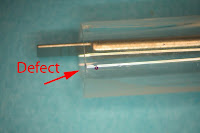

Glass expert performed a root cause failure analysis on failed reed switches. The upper left photograph shows the type of reed switch that was failing. This switch consists of two ferromagnetic “blades” that are enclosed in glass. At either end are leads that pass through glass-to-metal seals. The sealed tube is filled with inert gas which is introduced through a side tube that is heat sealed after the gas has been introduced. The switch is activated magnetically. The glass expert performed a glass failure analysis and determined that the glass envelopes were cracking due to the presence of mechanical damage (i.e. scratches) on the outer surface of the glass. All the cracks initiated at a flaw and then proceeded circumferentially till the two halves of the crack met on the opposite side from the origin. It is believed that the source of the failure stress was thermal stress generated by heating during potting and assembly. Without the pre-existing flaw on the outer glass surface, the switch would not have failed. The center photograph shows the initial crack leaving the origin in two directions. These two halves of the crack eventually meet on the side opposite the origin. The upper right photograph shows the surface flaw where the crack originated. These switches failed as a result of a manufacturing defect.





